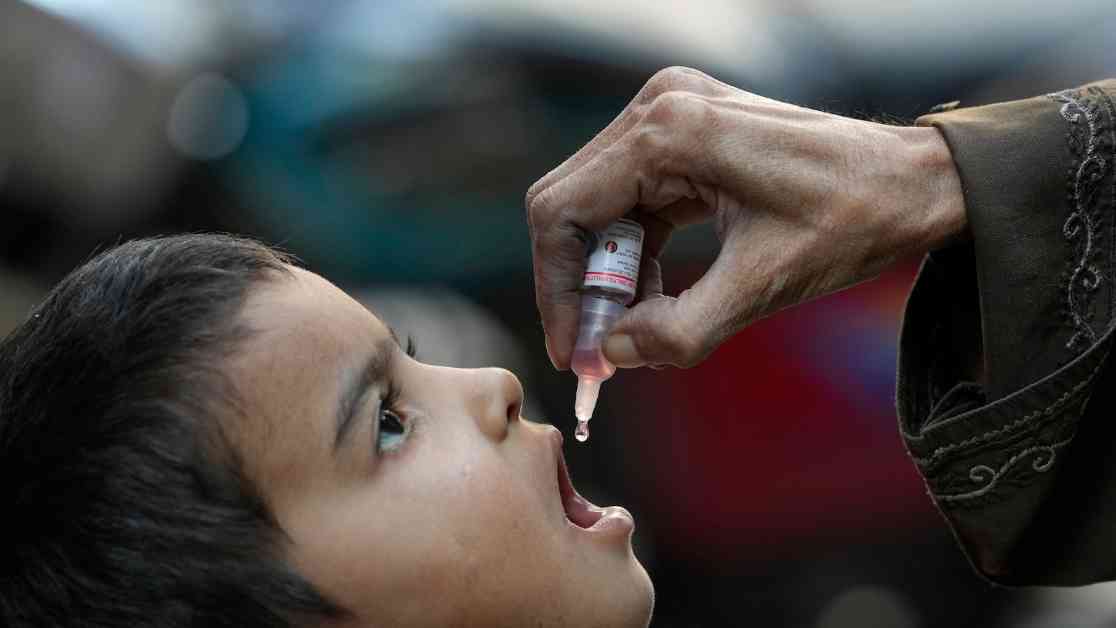Polio, once a feared and deadly disease, has been nearly eradicated from most parts of the world thanks to the efforts of the World Health Organization (WHO) and its partners. However, despite significant progress, polio continues to persist in a small number of countries, posing a challenge to global health efforts.
The Challenge of Polio Eradication
The recent case of polio infection in an unvaccinated baby in Gaza serves as a stark reminder of the ongoing threat that the disease poses. This is the first reported case of polio in Gaza in over 25 years, highlighting the importance of maintaining high vaccination rates to prevent outbreaks.
Polio is caused by a virus that primarily affects children under the age of five. While most people infected with polio do not show any symptoms, the disease can cause fever, headaches, vomiting, and stiffness of the spine. In severe cases, polio can invade the nervous system and lead to paralysis within hours. The WHO estimates that 1 in 200 polio cases results in permanent paralysis, usually affecting the legs. Tragically, up to 10% of children who are paralyzed by polio die when their breathing muscles are affected.
The History of Polio
Polio has been a scourge on humanity for centuries, with ancient Egyptian hieroglyphics depicting children with the telltale signs of the disease. Before the development of the first polio vaccine in the 1950s, outbreaks of the disease were a major cause of fear and suffering. The 1916 polio outbreak in New York alone claimed the lives of over 2,000 people, while the worst recorded U.S. outbreak in 1952 resulted in more than 3,000 deaths.
Survivors of polio often faced lifelong consequences, including paralysis and deformed limbs. Some individuals whose breathing muscles were affected by the disease required the use of “iron lung” chambers to assist with breathing. These devastating effects of polio underscored the urgent need for a vaccine to prevent future outbreaks.
The Global Effort to Eradicate Polio
In 1988, the WHO passed a resolution to eradicate polio, inspired by the successful elimination of smallpox eight years earlier. The original target was to eliminate polio by 2000, and significant progress was made in reducing polio cases by over 99%. However, Afghanistan and Pakistan remain as the only countries where the spread of polio has never been halted, with outbreaks also occurring in more than a dozen other countries, mainly in Africa.
To achieve the goal of eradicating polio by 2026, the WHO and its partners have ramped up efforts to vaccinate at least 95% of the population in all regions, including conflict-ridden areas and regions with weak health systems. The oral polio vaccine has been instrumental in preventing the spread of the disease, as it is affordable, easy to administer, and effective at preventing widespread infections.
The Challenges of Polio Eradication
Despite the progress made in reducing the number of wild polio virus cases, vaccine-related infections now account for the majority of polio cases worldwide. The oral polio vaccine contains weakened live virus, which in rare instances can cause polio in unvaccinated individuals. Moreover, the live virus in the vaccine can mutate into a new form capable of sparking outbreaks, further complicating eradication efforts.
Scott Barrett, a professor at Columbia University who has studied polio eradication, highlights the challenges of striving for perfection in eradicating polio. He notes that while the technical feasibility exists, the reality of an imperfect world with numerous weak links complicates the eradication process. Achieving global polio eradication requires overcoming various obstacles, including reaching vulnerable populations, ensuring high vaccination coverage, and addressing vaccine-related risks.
In conclusion, the persistence of polio serves as a reminder of the importance of ongoing vaccination efforts and global cooperation in combating infectious diseases. While significant progress has been made in reducing polio cases worldwide, challenges remain in achieving the ultimate goal of eradicating the disease. Through continued dedication, innovation, and collaboration, the world can strive towards a polio-free future for all.

















